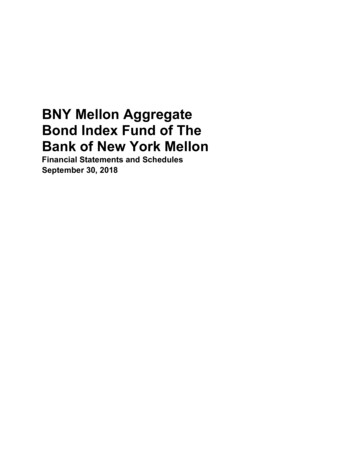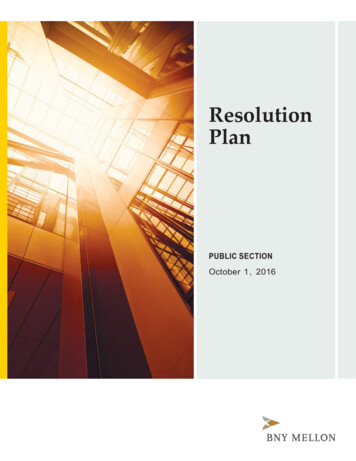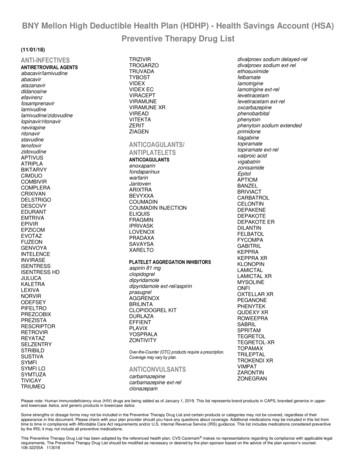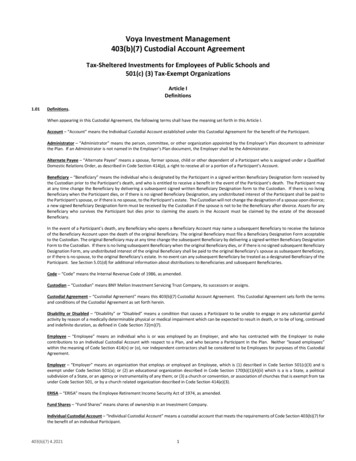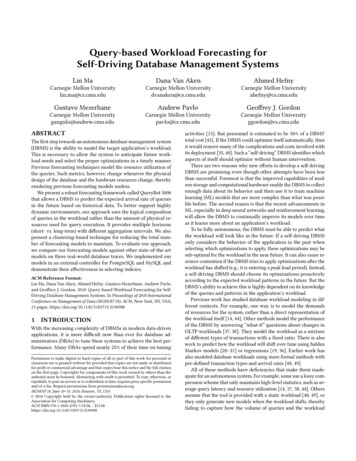
Transcription
BNY MELLON INVESTMENT SERVICING TRUST COMPANYSupplement to the Traditional and Roth Individual Retirement Account (IRA)Disclosure Statement for Tax Year 2022DEADLINE FOR 2021 CONTRIBUTIONS TO A TRADITIONAL OR ROTH IRA:Due to the Emancipation Day holiday observed in the District of Columbia, most eligible individuals will have until, Monday,April 18, 2022, to make contributions to a traditional IRA or Roth IRA for 2021. Note that, due to the Patriots’ Day holidayobserved on April 18, 2022, in Massachusetts and Maine, eligible individuals residing in those two states only will have untilTuesday, April 19, 2022. For more information, please refer to the Internal Revenue Service (IRS) web site: www.irs.gov.2022 IRA CONTRIBUTION LIMITS FOR TRADITIONAL AND ROTH IRA:The maximum allowable contribution to your IRAs (deductible, non-deductible, and Roth) for the tax year remains unchangedand is the lesser of (a) 6,000 or (b) 100% of your earned income. For those who have attained or will attain the age of 50before the close of the taxable year, the annual IRA contribution limit is increased by 1,000 (total of 7,000 for 2022).Any contribution made to your IRA will be treated as a current year contribution recorded in the year it is received, unlessthe contribution is made between January 1 and April 18, 2022 (or April 19, 2022, for eligible residents of Massachusettsand Maine), and you have identified the contribution as a prior year contribution. Please consult IRS Publication 590-A,Contributions to Individual Retirement Arrangements (IRAs) for eligibility requirements and contribution restrictions.2022 TRADITIONAL IRA INCOME TAX DEDUCTION:Your contribution to a traditional IRA may be deductible on your federal income tax return. However, there is a phase-out ofthe IRA deduction if you are an active participant in an employer-sponsored retirement plan. The IRA deduction is reducedproportionately as modified adjusted gross income increases. If you are not an active participant in an employer-sponsoredretirement plan, there is a phase-out of the IRA deduction if you’re married based on whether or not your spouse is covered bya workplace retirement plan. Please consult IRS Publication 590-A, Contributions to Individual Retirement Arrangements (IRAs) forassistance in calculating your deductible contribution as it pertains to individual income and employer-sponsored retirementplan circumstances. Your contribution in excess of the permitted deduction will be considered a non-deductible contribution.DEDUCTION LIMIT—Effect of Modified AGI on Deduction—Covered by a Retirement Plan at WorkTAX YEAR 2022Full deduction ifmodified AGI is:Partial deduction ifmodified AGI is:No deduction ifmodified AGI is:Single Filers or Head of Household 68,000 or lessMore than 68,000but less than 78,000 78,000 or moreMarried—filing jointly or Qualified Widow(er) 109,000 or lessMore than 109,000but less than 129,000 129,000 or moreMarried—filing separatelyN/ALess than 10,000 10,000 or moreDEDUCTION LIMIT—Effect of Modified AGI on Deduction—You are NOT Covered by a Retirement Plan at Work (Spousal CoverageConsidered)TAX YEAR 2022Full deduction ifmodified AGI is:Partial deduction ifmodified AGI is:No deduction ifmodified AGI is:Married—filing jointly—spouse covered at work 204,000 or lessMore than 204,000but less than 214,000 214,000 or moreMarried—filing separately—spouse covered at workN/ALess than 10,000 10,000 or more2022 ROTH IRA CONTRIBUTION ELIGIBILITY:For 2022, your Roth IRA contribution limit is reduced (phased out) based on your modified AGI as follows:TAX YEAR 2022Full deduction ifmodified AGI is:Partial deduction ifmodified AGI is:No deduction ifmodified AGI is:Married—filing jointly or Qualified Widow(er) 204,000 or lessMore than 204,000but less than 214,000 214,000 or moreMarried—filing separatelyN/ALess than 10,000 10,000 or moreSingle, Head of Household or Married—filing separately andyou did not live with your spouse at any time during the yearLess than 129,000At least 129,000but less than 144,000 144,000 or moreThese limits may be adjusted from time to time by the Internal Revenue Service (“IRS”); please refer to Publication 590-A Contributions toIndividual Retirement Arrangements (IRAs) for current year limits.
REQUIRED DISTRIBUTIONS FROM A TRADITIONAL IRA:Note that the IRS Uniform Lifetime Distribution Period Table referenced in the Traditional IRA Disclosure Agreement for use incalculating Required Minimum Distributions (RMDs) has been updated. The updated Table is applicable for distribution calendaryears beginning on or after January 1, 2022. Until such time as the IRS updates Publication 590-B, Distributions from IndividualRetirement Arrangements (IRAs), the updated Tables can be found in the Federal Register article located at pdf/2020-24723.pdf. The Uniform Lifetime Table can be found on page 7 of 32 of the article.ROTH INDIVIDUAL RETIREMENT ACCOUNT DISCLOSUREEARLY DISTRIBUTIONS FROM A ROTH IRA:Early Distribution Penalty Tax – If you are under age 59½ and receive a nonqualified Roth IRA distribution, an additional earlydistribution penalty tax of 10% generally will apply to the amount includible in income in the year of the distribution. If youare under age 59½ and receive a distribution of conversion amounts or employer-sponsored retirement plan rollover amountswithin the five-year period beginning with the year in which the conversion or employer-sponsored retirement plan rollover occurred, an additional early distribution penalty tax of 10% generally will apply to the amount of the distribution. The additionalearly distribution penalty tax of 10% generally will not apply if one of the following exceptions apply. The 10% penalty tax is inaddition to any federal income tax that is owed at distribution.1. Death—After your death, distributions made to your beneficiary.2. Disability—If at the time of distribution, you are disabled (within the meaning of section 72(m)(7) of the Internal RevenueCode)3. Substantially equal periodic payments—You are not subject to the additional 10% early distribution penalty tax if you aretaking a series of substantially equal periodic payments (at least annual payments) over your life expectancy or the joint lifeexpectancy of you and your beneficiary.14. Unreimbursed medical expenses—If you take payments to pay for unreimbursed medical expenses that exceed a specifiedpercentage of your adjusted gross income. The medical expenses may be for you, your spouse, or any dependent listed onyour tax return.15. Health insurance premiums—If you are unemployed and have received unemployment compensation for 12 consecutiveweeks under a federal or state program, you may take payments from your Roth IRA to pay for health insurance premiums.16. Higher education expenses—Payments taken for certain qualified higher education expenses for you, your spouse, or thechildren or grandchildren of you or your spouse.17. First-time homebuyer—You may take payments from your Roth IRA to use toward qualified acquisition costs of buying orbuilding a principal residence. The amount you may take for this reason may not exceed a lifetime maximum of 10,000.The payment must be used for qualified acquisition costs within 120 days of receiving the distribution.18. IRS levy—Payments from your Roth IRA made to the U.S. government in response to a federal tax levy.9. Qualified reservist distributions—If you are a qualified reservist member called to active duty for more than 179 days or anindefinite period, the payments you take from your Roth IRA during the active duty period.110. Qualified birth or adoption—Payments from your Roth IRA for the birth of your child or the adoption of an eligible adopteewill not be subject to the 10% early distribution penalty tax if the distribution is taken during the one-year period beginningon the date of birth of your child or the date on which your legal adoption of an eligible adoptee is finalized. An eligibleadoptee means any individual (other than your spouse’s child) who has not attained age 18 or is physically or mentally incapable of self-support. The aggregate amount you may take for this reason may not exceed 5,000 for each birth or adoption.1You must file IRS Form 5329 along with your income tax return to the IRS to report and remit any additional taxes if yourdistribution is not for one of the above reasons.We do not report distributions for these exceptions on IRS Form 1099-R as exempt from the early distribution penalty. You must file IRSForm 5329 along with your income tax return to the IRS to claim a penalty tax exception for this reason.1The above is general information on Roth IRA distributions. You may wish to review IRS Publication 590-B, Distributions from Individual Retirement Arrangements (IRAs), from the IRS or refer to the IRS website at www.irs.gov. If you have questions about whether a distribution includes any amount subject to federal income or the 10% early distribution tax, please speak with a qualifiedtax professional.Matthews Asia Fundsmatthewsasia.com II
TRADITIONAL INDIVIDUAL RETIREMENT ACCOUNT DISCLOSUREEARLY DISTRIBUTIONS FROM A TRADITIONAL IRA:Early Distribution Penalty Tax – If you are under age 59½ and receive a Traditional IRA distribution, an additional earlydistribution penalty tax of 10% generally will apply to the amount includible in income in the year of the distribution.However, the additional early distribution penalty tax of 10% generally will not apply if one of the following exceptions apply.The 10% penalty tax is in addition to any federal income tax that is owed at distribution.1. Death - After your death, distributions made to your beneficiary.2. Disability – If at the time of distribution, you are disabled (within the meaning of section 72(m)(7) of the Internal RevenueCode)3. Substantially equal periodic payments – You are not subject to the additional 10% early distribution penalty tax if youare taking a series of substantially equal periodic payments (at least annual payments) over your life expectancy or the jointlife expectancy of you and your beneficiary.14. Unreimbursed medical expenses – If you take payments to pay for unreimbursed medical expenses that exceed a specifiedpercentage of your adjusted gross income. The medical expenses may be for you, your spouse, or any dependent listed onyour tax return.15. Health insurance premiums – If you are unemployed and have received unemployment compensation for 12 consecutiveweeks under a federal or state program, you may take payments from your Traditional IRA to pay for health insurance premiums.16. Higher education expenses – Payments taken for certain qualified higher education expenses for you, your spouse, or thechildren or grandchildren of you or your spouse.17. First-time homebuyer – You may take payments from your Traditional IRA to use toward qualified acquisition costs ofbuying or building a principal residence. The amount you may take for this reason may not exceed a lifetime maximum of 10,000. The payment must be used for qualified acquisition costs within 120 days of receiving the distribution.18. IRS levy – Payments from your Traditional IRA made to the U.S. government in response to a federal tax levy.9. Qualified reservist distributions – If you are a qualified reservist member called to active duty for more than 179 days oran indefinite period, the payments you take from your Traditional IRA during the active duty period.110. Qualified birth or adoption – Payments from your Traditional IRA for the birth of your child or the adoption of an eligibleadoptee will not be subject to the 10% early distribution penalty tax if the distribution is taken during the one-year periodbeginning on the date of birth of your child or the date on which your legal adoption of an eligible adoptee is finalized. Aneligible adoptee means any individual (other than your spouse’s child) who has not attained age 18 or is physically or mentally incapable of self-support. The aggregate amount you may take for this reason may not exceed 5,000 for each birth oradoption.1You must file IRS Form 5329 along with your income tax return to the IRS to report and remit any additional taxes if yourdistribution is not for one of the above reasons.We do not report distributions for these exceptions on IRS Form 1099-R as exempt from the early distribution penalty. You must file IRSForm 5329 along with your income tax return to the IRS to claim a penalty tax exception for this reason.1The above is general information on Traditional IRA distributions. You may wish to review IRS Publication 590-B, Distributionsfrom Individual Retirement Arrangements (IRAs), from the IRS or refer to the IRS website at www.irs.gov. If you have questionsabout whether a distribution includes any amount subject to federal income or the 10% early distribution tax, please speakwith a qualified tax professional.Matthews Asia Fundsmatthewsasia.com III
Matthews Asia Funds Individual Retirement Account (IRA)New Account ApplicationTraditional IRASEP IRARoth IRATable of ContentsCombined Disclosure Statement1Traditional Individual Retirement Account Disclosure5Roth Individual Retirement Account Disclosure10Traditional IRA Custodial Account Agreement14Roth IRA Custodial Account Agreement21Traditional and Roth IRA Application andAdoption Agreement Instructions26Application and Adoption Agreement28Certification of Rollover Assets33Transfer of Assets/Direct Rollover Form35Privacy Notice37References to the "Custodian" mean BNY Mellon Investment Servicing Trust Company.RETIRE APP 0622
Traditional and Roth Individual Retirement Account (IRA)Combined Disclosure StatementThe following information is the disclosure statement required by federal tax regulations. You should read this DisclosureStatement, the Custodial Account Agreement and the prospectuses for the mutual funds in which your IRA contributions willbe invested. The rules governing IRAs are subject to change. You should consult Internal Revenue Service “IRS” Publication590 or the IRS web site www.irs.gov for updated rules and requirements.IMPORTANT INFORMATION ABOUT U.S. GOVERNMENT REQUIREMENTS THAT MAY AFFECT YOUR ACCOUNTBNY Mellon Investment Servicing Trust Company (“BNY Mellon”, “we”, or “us”), provides custodial and administrativeservices for your retirement or savings account. As a result of this role, persons who open a retirement or savings account areconsidered ‘customers’ of BNY Mellon (“you” or “your”).To help the U.S. Government fight the funding of terrorism and money laundering activities, Federal law requires BNY Mellon,as a financial institution, to obtain, verify, and record information that identifies each person who opens an account. Allaccounts we open are opened on a conditional basis – conditioned on our ability to verify your identity in accordance withFederal law.When establishing an account, you are required to provide your full legal name, address, government issued identificationnumber (e.g. social security number), date of birth, and other information within your account-opening application thatwill allow us to identify you. We may also request a copy of your driver’s license or other identifying documents and mayconsult third-party databases to help verify your identity. If the account you are opening will be registered in the name of abeneficiary, trust, or estate or charity, we may require additional identifying documentation.If you fail to provide any requested identifying information or documentation when opening your account, your newaccount application may be rejected.If we open your account, and you subsequently fail to provide all identification materials we request or if we aresubsequently unable to adequately verify your identity as required by U.S. Government regulations, we reserve the rightto take any one or more of the following actions: We may place restrictions on your account which block all purchase transactions and we may place additional restrictionson your account blocking other transactional activities if we determine such additional restrictions are appropriate underFederal law or regulation. We may close your account, sell (i.e., “liquidate”) the assets in your account in the prevailing market at the time, and sendyou a check representing the cash proceeds of your account. This distribution will be reported to the IRS and may result inunfavorable consequences to you under Federal and state tax laws.You May Incur Losses. Despite being opened as a conditional account, your account will be invested as you instruct and youwill be subject to all market risks during the period between account opening and any liquidation necessitated by your failureto furnish requested identifying information or by an inability to adequately verify your identity. You may also be subject toadditional market risks if the additional transactional restrictions discussed above are placed on your account. In addition, theclosing of your account may subject you to fees and charges imposed by a sponsor, issuer, depository or other person or entityassociated with one or more of the assets in which you are invested, and any sales charges you may have paid in connectionwith your purchases will not be refunded.You Assume All Responsibility For These Losses. BNY expressly disclaims any responsibility or liability for losses you incur asresult of your failure to furnish identification materials we request, including investment losses and any other loss or damage(including but not limited to lost opportunities and adverse tax consequences). If you proceed with the account openingprocess, you accept all risks of loss resulting from any failure of yours to furnish the identification materials we request or froma subsequent inability to adequately verify your identity in accordance with Federal law or regulation.STATE UNCLAIMED PROPERTY LAW DISCLOSUREThe assets in your custodial account are subject to state unclaimed property laws which provide that if no activity occurs inyour account within the time period specified by the particular state law, your assets must be transferred to the appropriatestate. We are required by law to advise you that your assets may be transferred to an appropriate state in compliance withthese state laws.Matthews Asia Fundsmatthewsasia.com 1
REQUIRED FEDERAL INCOME TAX WITHHOLDING ON ESCHEATED TRADITIONAL IRA ACCOUNTSEffective as of January 1, 2020, for any Traditional IRA Account that becomes dormant and subject to escheatment understate unclaimed property law, the Internal Revenue Service requires reporting of the amount escheated on IRS Form 1099Rand income tax withholding at the time of escheatment to the state. You agree and authorize the Custodian to liquidatesufficient assets in your custodial account to provide for the withholding to the IRS. The Custodian will remit withholdingto the IRS in accordance with any prior withholding election. If you have not made a prior withholding election, theCustodian will remit withholding at a rate of ten percent (10%).REVOCATION OF YOUR IRAYou have the right to revoke your IRA and receive the entire amount of your initial investment by notifying the Custodianin writing within seven (7) days of establishing your IRA (account open date). If you revoke your IRA within seven days, youare entitled to a return of the entire amount contributed, without adjustment for such items as sales commissions,administrative expenses, or fluctuations in market value. If you decide to revoke your IRA, notice should be delivered ormailed to the address listed in the application instructions. This notice should be signed by you and include the following:1. The date.2. A statement that you elect to revoke your IRA.3. Your IRA account number.4. The date your IRA was established.5. Your signature and your name printed or typed.Mailed notice will be deemed given on the date that it is postmarked, if it is properly addressed and deposited either in theUnited States mail, first class postage prepaid, or with an IRS approved overnight service. This means that when you mailyour notice, it must be postmarked on or before the seventh day after your IRA was opened. A revoked IRA will be reportedto the IRS and the Depositor on IRS Forms 1099-R and 5498.CONTRIBUTIONSFor 2021, the maximum allowable contribution to your individual retirement accounts (deductible, non-deductible, andRoth) is the lesser of (a) 6,000 or (b) 100% of your earned income. If you are submitting a prior year contribution, the limitwas set at 6,000.Age 50 or above catch-up contributions—For those who have attained the age of 50 before the close of the taxable year, theannual IRA contribution limit is increased by 1,000.For tax years after 2021, the above limits may be subject to IRS cost-of-living adjustments, if any. Please read the Traditionaland Roth Individual Retirement Account Combined Disclosure Statement carefully or consult IRS Publication 590 or aqualified tax professional for more information about eligibility requirements and contribution restrictions.Making an IRA contribution on behalf of your spouse - If you have earned compensation, are married and file a joint federalincome tax return, you may make an IRA contribution on behalf of your working or nonworking spouse. The total annualcontribution limit for both IRAs may not exceed the lesser of the combined compensation of both spouses or the annualIRA contribution limits as set forth by the IRS. Contributions made on behalf of a spouse must be made to a separate IRAaccount established by your spouse.Any contribution made to your IRA will be treated as a contribution for the year it is received, unless the contribution ismade between January 1 and the April 15th postmark deadline and you have identified the contribution as a prior yearcontribution. TRADITIONAL IRA CONTRIBUTION RESTRICTION—Effective as of January 1, 2020, the maximum age of 70 ½ fortraditional IRA contributions has been repealed. Beginning in 2020, IRA owners who have reached age 70 ½, or older,may make a contribution, provided they have earned income for the year. This change does not allow owners over theage of 70 ½ to make a 2019 or prior contribution, however. ROTH IRA CONTRIBUTION—There is no age restriction for contributions to a Roth IRA, as long as the requirements ofearned income are met.DESCRIPTION OF AVAILABLE OPTIONS FOR YOUR CONTRIBUTIONSThe assets in your custodial account will be invested in accordance with instructions communicated by you (or followingyour death, by your beneficiary) or by your (or following your death, your beneficiary’s) authorized agent. Accountcontributions may be invested in shares of one or more mutual funds made available to you in connection with this IRAMatthews Asia Fundsmatthewsasia.com 2
account (the “Mutual Funds”), or in other investments that are eligible for investment under section 408(a) of the InternalRevenue Code and that are acceptable to the Custodian as investments under the Individual Retirement Account (IRA)Application and Adoption Agreement.Mutual Fund Investments: An investment in any of the Mutual Funds involves investment risks, including possibleloss of principal. In addition, growth in the value of your Mutual Funds is neither guaranteed nor protected due to thecharacteristics of a mutual fund investment. Detailed information about the shares of each Mutual Fund available to youfor investment of your IRA contributions must be furnished to you in the form of a prospectus. The method for computingand allocating annual earnings is set forth in the prospectus. (See the section of each prospectus entitled “Dividends.”) Theprospectus also sets forth the costs and expenses you incur by being invested in a particular Mutual Fund; such costs andexpenses reduce any yield you might obtain from the Mutual Funds. (See the section of the prospectus entitled “ExpenseTable” and the sections referred to therein). For further information regarding expenses, earnings, and distributions of aparticular Mutual Fund, see that Mutual Fund’s financial statements, prospectus and/or statement of additional information.In Article VIII, Section 23 of the TRADITIONAL IRA CUSTODIAL ACCOUNT AGREEMENT and Article IX, Section 23of the ROTH IRA CUSTODIAL ACCOUNT AGREEMENT (“Sections 23”), both of which constitute an important part ofthe APPLICATION and ADOPTION AGREEMENT, you authorize the Custodian to act in its discretion for your benefit insituations where assets in your custodial account are liquidated and the Custodian has not received instructions from youin a timely manner regarding the disposition of such proceeds or where the only instructions received from you cannotreasonably or practicably be carried out. For example, a Mutual Fund may take actions which result in that Mutual Fund, orin your investment in that Mutual Fund, being involuntarily liquidated. The Mutual Fund or the prospectus for that MutualFund may direct that the proceeds of the liquidation be placed in an asset not available to you under the APPLICATIONand ADOPTION AGREEMENT or provide solely that the cash or other property resulting from the liquidation be distributeddirectly to shareholders. If the Custodian does not receive timely instructions from you that it can reasonably andpracticably carry out (for example, in-kind property distributed by the Mutual Fund may not be a permissible asset for yourIRA), then in both Sections 23 you authorize the Custodian to exercise its discretion in acting on your behalf, includingtaking such actions as placing the proceeds in a money market mutual fund, an FDIC-insured bank account or moneymarket account, distributing the proceeds to you or holding the proceeds uninvested. Other examples may exist involvingdifferent liquidation circumstances and different restrictions or limitations regarding the disposition of the proceeds. TheCustodian expressly disclaims any liability for any action taken or omitted under the authority of either Section 23, unlessthe Internal Revenue Code or regulations implementing the Internal Revenue Code require otherwise.BENEFICIARY DESIGNATIONSPer Stirpes Beneficiary Designations: The Custodian shall accept as complete and accurate all written instructions providedin good order by the estate/executor with regard to the identification of the beneficiaries and the allocations thereto.In the event of your death, the balance of your custodial account shall be paid to the primary beneficiaries who surviveyou in equal shares (or in the specified shares, if indicated). If none of the primary beneficiaries survive you, the balanceof your account shall be paid to the contingent beneficiaries who survive you in equal shares (or in the specified shares, ifindicated). If you name multiple primary beneficiaries and a beneficiary does not survive you, such interest is terminatedand that percentage will be divided proportionately among the remaining primary beneficiaries. Similarly, unless you havespecified otherwise, if no primary beneficiary survives you and you have named multiple contingent beneficiaries and abeneficiary does not survive you, such interest is terminated and that percentage will be divided proportionately among theremaining contingent beneficiaries.You may change your beneficiaries at any time by giving written notice to the Custodian. If you do not designate abeneficiary, or if all designated beneficiaries predecease you, your surviving spouse will become the beneficiary of your IRA.If you do not have a surviving spouse at the time of your death, your estate will become the beneficiary of your IRA. If atrust is designated as a beneficiary, you must provide both the date of the trust and the name(s) of the trustee(s).SPOUSAL BENEFICIARY DESIGNATION IN THE EVENT OF DIVORCEIn the event of a divorce or legal separation, the Custodian will not automatically remove the former spouse as thedesignated beneficiary without court appointment. If your life circumstances have changed, we suggest you submit an IRABeneficiary Designation Form. The current beneficiary designation on file with the Custodian will be deemed valid and infull force until such date as the Custodian receives a signed IRA Beneficiary Designation Form, in good order.SPOUSAL PROVISIONS FOR SAME SEX COUPLESIn accordance with federal regulations, where an individual is lawfully married to another individual, regardless of sex, bothindividuals shall be treated as a “spouse” for federal tax purposes. Individuals in a civil union or domestic partnership willnot be treated as spouses for federal tax purposes.Matthews Asia Fundsmatthewsasia.com 3
TAX REFUND DIRECT DEPOSIT IRA CONTRIBUTIONSTaxpayers who qualify for a tax refund may elect to directly deposit their refund into their IRA account. The amount of therefund deposited to your IRA cannot exceed annual IRA limits as set forth by the Internal Revenue Service. You must contactthe Custodian in advance of completing IRS Form 8888 to obtain the proper routing instructions. All tax refund contributionswill be recorded as current year contributions for the year received.HEALTH SAVINGS ACCOUNT (“HSA”) FUNDING DISTRIBUTIONYou are allowed a one-time, tax-free transfer from an IRA (other than a SEP or SIMPLE IRA) to use toward your annual HealthSavings Account (“HSA”) contribution. Eligible individuals may make an irrevocable one-time, tax-free “qualified HSA fundingdistribution” from an IRA and move it directly into an HSA, subject to strict requirements. The HSA funding distribution mustbe directly transferred from the IRA custodian or trustee to the HSA custodian or trustee. The amount of the transfer cannotexceed the maximum HSA contribution limit for the year that the amount is transferred. The deposited amount is countedtoward the individual’s total HSA annual con
retirement plan, there is a phase-out of the IRA deduction if you're married based on whether or not your spouse is covered by . Traditional and Roth Individual Retirement Account (IRA) BNY Mellon Investment Servicing Trust Company ("BNY Mellon", "we", or "us"), provides custodial and administrative .



